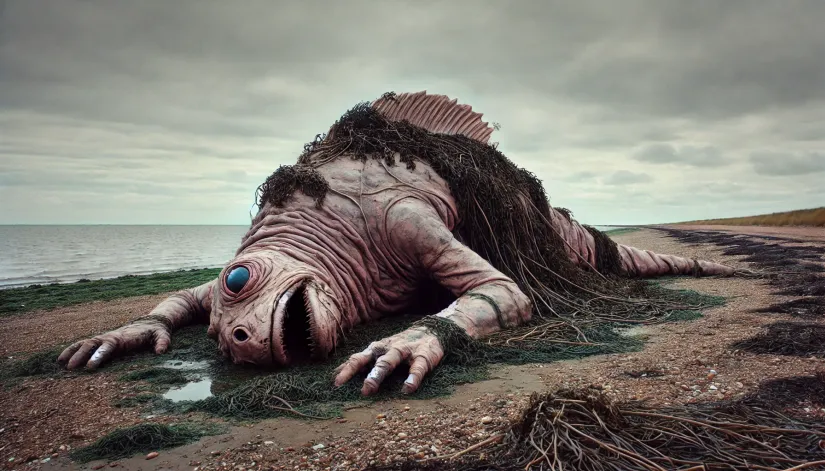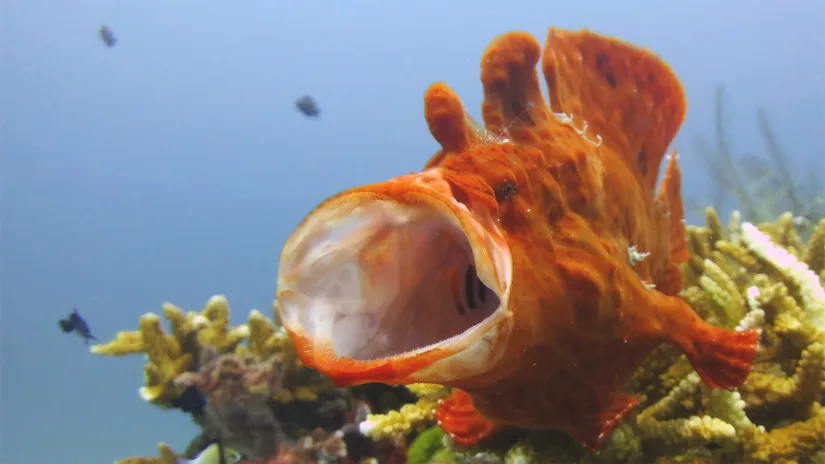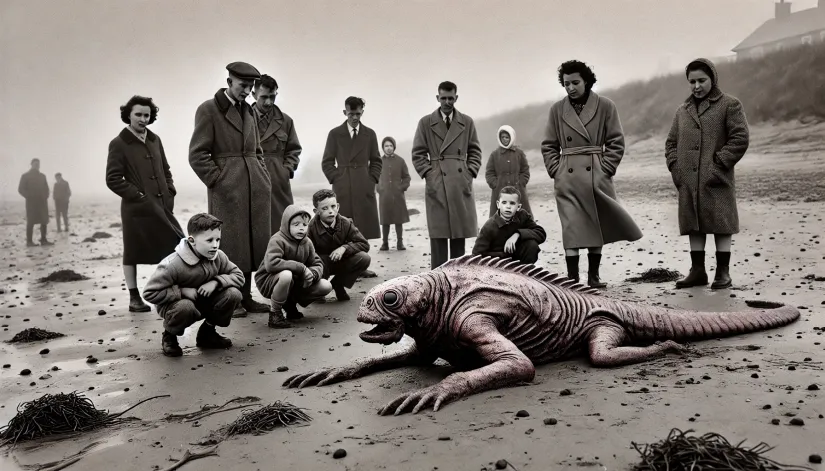The Canvey Island Monster is a strange cryptid first spotted on a small island off the coast of England. However, its bizarre physical descriptions and possible links to environmental controversy have kept the story alive.
Was it a byproduct of pollution? An unknown deep-sea creature? Or simply a hoax that spiraled out of control?
Here’s what we know:
In this article:

The Canvey Island Pollution Controversy
A big part of this European cryptid legend is tied to what happened on Canvey Island. So, let’s start with that.
Canvey Island is a reclaimed area in the Thames Estuary, near the North Sea. It is characterized by its mudflats and brackish waters, influenced by both freshwater from the Thames River and saltwater from the North Sea.
However, in the early 1950s, Canvey Island’s environment changed significantly. What happened? A significant increase in industrial activity around the Thames Estuary (particularly with the rise of petrochemical industries and local manufacturing plants).
Of course, many factories along the river discharged untreated waste. Dangerous chemicals like heavy metals (arsenic and lead), polychlorinated biphenyls (PCBs), petroleum byproducts, and industrial solvents.
These chemicals entered the estuary and accumulated in the mudflats and the surrounding water. In time, the combination of different types of runoff led to a toxic environment that severely impacted local marine and estuarine life.
The unique Canvey Island ecosystem—characterized by both shallow estuarine environments and deeper waters—was especially vulnerable to such contamination. For example, the Thames Estuary was already notorious for its poor water quality—often described as a “dead river” due to the lack of oxygen and widespread pollution.
So, the extra pollution from the factories only made things worse. It not only impacted the fish population, but it also led to deformities or unusual mutations in aquatic animals. Reports of dead (or disfigured) fish washing up on shores during this time were common.
Canvey Island Monster Sightings
The Canvey Island Monster sightings happened during this period. The first two happened in 1953, followed by another alleged sighting in 1954.

1953 Sightings
The first two alleged Canvey Island Monster sightings happened in November 1953. The first one comes from Colin Day, who was just nine years old at the time.
Day recalls that while walking along the beach, he saw a group of children gathered around something strange. When he approached, he saw the creature and even touched it.
He described its flesh as “not fish-like” but more like “wobbly human flesh with an orange peel texture.” Day initially thought it was a person. In a later interview, he recalled shouting at the other children that it was a “mermaid.”
After a few days, another strange, unrecognizable creature washed ashore on the Canvey Island beach. Locals, including a fisherman and his family, were walking along the beach when they came across its eerie appearance.
SpookySight recommends:
- The Surgeon’s Photograph: Was This the Loch Ness Monster’s Greatest Evidence?
- Tatzelwurm: The Alpine Cryptid You’ve Never Heard Of
- Mongolian Death Worm: Fact or Fiction? Inside the Gobi Desert’s Greatest Mystery
According to reports, the creature was around 2.5 feet (76 cm) long, with thick, pinkish skin that looked leathery and had an “orange peel texture.”
It also looked bizarre: large, bulbous eyes, gills, two pectoral fins, and a gaping mouth with small, sharp teeth. Most notably, it had two legs ending in five toes. Some described the legs as hooved or concave, like horseshoes.
Shocked by the sight, the residents covered the creature with seaweed and contacted the local authorities.
Unfortunately, by the time zoologists arrived (including Alwyne Wheeler, an ichthyologist from the British Natural History Museum), the body had decomposed significantly. Its poor condition made it difficult to gather much information.
To make matters worse, the authorities cremated the remains in December 1953, leaving no chance for proper examination or identification.
The initial discovery left many confused. Was it a deep-sea creature? A hoax? Or perhaps an unknown species? These questions were on everyone’s mind.
1954 Sighting
Less than a year later, in August 1954, another carcass washed ashore on a similar stretch of Canvey Island, this time near the Labworth Café on the island’s southeastern coast.
This creature was discovered by Reverend Joseph Overs, known locally as “The Canvey Photographer,” due to his passion for documenting local events.
Interestingly, this new specimen was much larger, measuring around 3.9 feet (120 cm) in length and weighing approximately 25 pounds (11.3 kg). And, unlike the first carcasses, this one was in much better condition. Which, of course, allowed for more detailed observations.
The strange sea creature had many of the same features as the first—pinkish skin, gills, large staring eyes, and two legs ending in five toes. It also had prominent pectoral fins on either side of its body and a tail fin, which made it look even more fish-like.
Reverend Overs took several photographs of the creature. However, only one of those photographs was officially released to the public. Though it was not widely circulated and later became difficult to verify.
What we can’t explain is how this carcass also “vanished” without a trace after a brief examination by local officials. No official records. No public expanation. Nothing.

Public Reaction
The Canvey Island Monster sightings were covered by local newspapers, including the Essex Chronicle and the Southend Standard, but were mostly ignored by mainstream media.
Reverend Overs’s photograph was published locally under the title “Fish with feet found on beach.”
The initial reactions from the public varied. Some people believed the creature was a hoax, while others thought it was a deep-sea animal that was washed ashore due to unusual tides or pollution.
Rumors of mermaids or even extraterrestrial beings spread throughout the community.
Canvey Island Monster Theories and Possible Explanations
Let’s start with some of the theories that circulated over the years. Then, we will offer our theory, too.

Frogfish
One of the most popular theories is that the Canvey Island Monster was an unknown species of deep-sea frogfish (family Antennariidae). This idea was suggested by Dr. Alwyne Wheeler, who was called to examine one of the carcasses found in 1953.
These species use its pectoral fins to “walk” along the ocean floor. However, the frogfish is much smaller than the Canvey Island Monster, making it an unlikely explanation for the cryptid. Typically, the frogfish range from 2.5 to 15 inches (6 to 38 cm) in length, which is far smaller than the 2.5 to 3.9 feet (76 to 120 cm) size reported in the Canvey Island sightings.
On top of that, frogfish are usually found in tropical waters, which makes this theory less likely given the colder climate of the Thames Estuary.
Humanoid Creature or Alien?
Some locals thought the creature had humanoid characteristics, leading to speculation that it could be a mermaid or even an extraterrestrial being.
For example, Colin Day recalled calling it a “mermaid.” Similarly, Reverend Joseph Overs mentioned a few times that he heard people refer to the creature as a half-human, half-fish monster.
However, there is no verifiable basis for this theory.
Genetic Mutation
Another hypothesis suggests that the Canvey Island Monster may have been the result of genetic mutations—likely caused by pollution.
The idea is interesting. And it aligns with more recent observations of other mutated species found in heavily polluted environments.
Although no direct evidence supports this idea, it remains one of the more scientific explanations for the unusual characteristics observed in the creature.
Exotic Animal Escape
In the 1950s, exotic animals were sometimes imported and kept privately, often without proper containment. It is entirely possible that the creature escaped from a private collection or even a ship carrying exotic animals as cargo.

Our Theory
At SpookySight, we have a simple yet convincing theory: the Canvey Island Monster was a monkfish (also known as Poor Man’s Lobster).
Monkfish (Genus Lophius) are bottom feeders with a reputation for being as delicious as they are hideous.
Their pectoral fins can resemble limbs, especially in a decomposed state, which might explain why locals believed the creature had “legs.” The leathery skin and large, bulbous eyes also match the features of a monkfish—something that may have appeared even more grotesque after washing ashore and decomposing in the elements.
What makes this theory particularly intriguing is how strange it is that the creature wasn’t identified as a monkfish at the time, especially considering how well-known these fish are in the U.K. They are common in the North Atlantic and are often found in the waters around the United Kingdom.
Or perhaps the Canvey Island Monster was identified correctly, so the authorities didn’t bother with any official statements?







